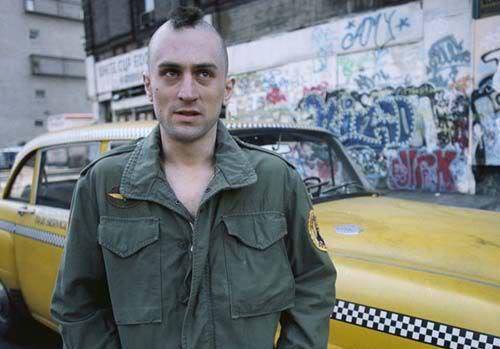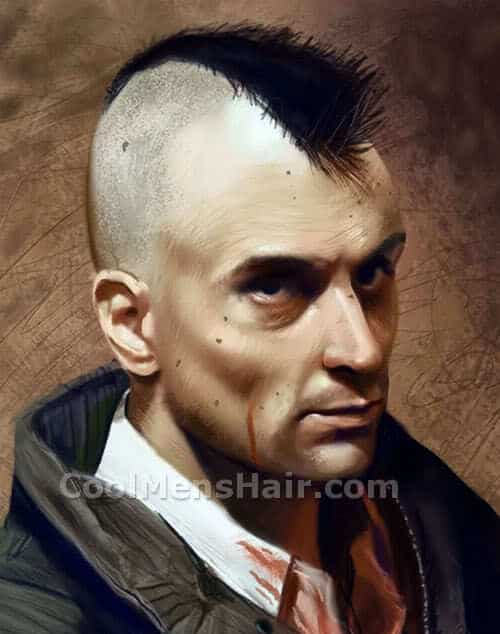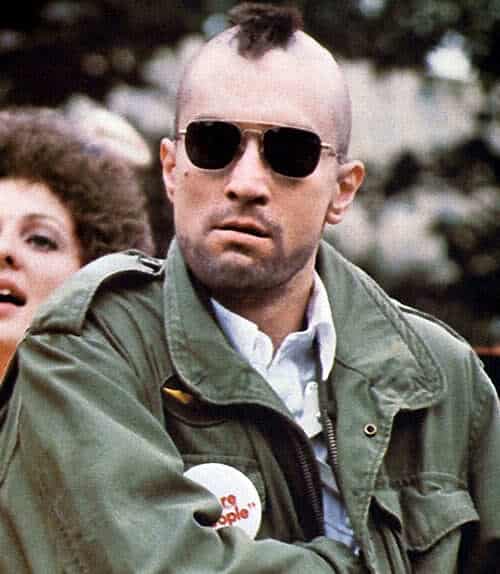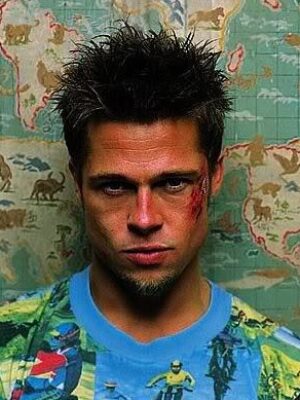Travis Bickle is the name of the character played by Robert de Niro in the film Taxi Driver (1976). Bickle is a former marine who served honorably in the Vietnam War. He does not have many friends, and he suffers from a bad case of insomnia.
Therefore, he takes a job as a night shift cabbie in a bad neighborhood. He becomes a vigilante bent on saving a twelve-year-old prostitute. However, here, we are interested in looking at the Travis Bickle mohawk haircut. His manly haircut became so trendy that many still copy his mohawk hairstyle.
Robert De Niro as Travis Bickle in Taxi Driver movie.
After being rejected by a woman, Bickle becomes somewhat paranoid. He begins carrying a variety of weapons, shaves his hair into a Mohawk, and begins to practice being a “tough guy”. This is the origin of de Niro’s famous line, “You talkin’ to me?”
Travis Bickle mohawk hairstyle.
The Bickle Mohawk has the sides of the head shaved completely. The hair in the back of the stripe is cut very short. As the hair fades toward the front of the head it gets progressively longer, reaching a length of about two inches above the forehead.
Travis Bickle with mohawk hair and aviator sunglasses.
Wax was used to provide the hold needed to make the hair stand on end. There were no spikes or anything fancy, just the hair standing up in an abbreviated fan. When viewed from the side, The strip of hair looked similar to the profile of a flat top, a short hairstyle that Bickle might have worn while in the military.
This is very different from the average style of Mohawk. Most people have the remaining hair cut to a uniform length from the front to the back. Some wear it longer and styled into a fan or into liberty spikes. Others wear it shorter, more like the length of the hair in the back. However, the Travis Bickle Mohawk haircut has earned its place in history, partially due to the actions of the character in the movie.
The Character Travis Bickle
Travis Bickle is a fictional character and the protagonist of Martin Scorsese’s 1976 film “Taxi Driver,” which was written by Paul Schrader. He’s not a real person, but his impact on popular culture has been significant.
In the film, Travis Bickle is a 26-year-old honorably discharged U.S. Marine, living in New York City in the aftermath of the Vietnam War. Travis struggles with chronic insomnia and finds a job as a nighttime taxi driver to occupy his hours. He’s portrayed as a lonely, isolated figure, troubled by the urban decay and moral corruption he sees around him in the city.
Travis becomes infatuated with a campaign volunteer named Betsy but fails in his attempts to connect with her, which further drives him into isolation and despair. He also develops a sort of protective relationship with a 12-year-old sex worker named Iris, played by Jodie Foster, and attempts to rescue her.
Travis is deeply disturbed and starts to unravel as the film progresses, taking it upon himself to act violently against the perceived immorality that he sees in the city. The film culminates in a bloody rampage, after which, ironically, Travis is hailed as a hero by the media.
“Taxi Driver” is widely regarded as one of the greatest films of all time, and Robert De Niro’s portrayal of Travis Bickle is considered one of his most iconic roles. Travis Bickle’s character has been analyzed in many ways: as a depiction of the effects of loneliness and alienation, as a reflection of post-Vietnam War American societal changes, and as an examination of the blurred lines between heroism and vigilantism.
Notably, the character of Travis Bickle has been cited as an influence on John Hinckley Jr., who attempted to assassinate U.S. President Ronald Reagan in 1981, reportedly as an effort to impress actress Jodie Foster, who he had become obsessed with because of her role in “Taxi Driver.”










